867+Brackets in Quotes: What They Mean and How to Use Them Correctly
Understanding how to use brackets in quotes is essential for anyone who wants to write with clarity and accuracy—especially when quoting others.
Whether you’re a student, journalist, academic, or everyday writer, brackets help clarify meaning, modify quotes, or insert necessary context without altering the original speaker’s intent.
Misusing them can lead to misinterpretation or misinformation. This guide will explain how, when, and why to use brackets—especially square brackets—in quotes with clear examples.
Explore real-world quotes that show how brackets function to improve understanding and ensure your writing remains both ethical and precise.
How to Use Brackets in Quotes

🔹 She [the professor] explained the concept clearly.
🔹 “He [the CEO] refused to comment on the issue.”
🔹 “It [the solution] worked better than expected.”
🔹 “They [the researchers] found a link between diet and sleep.”
🔹 “He told us [the interns] to be ready by 9 a.m.”
🔹 “The suspect [John Doe] confessed under pressure.”
🔹 “We visited their headquarters [in Berlin] last summer.”
🔹 “She was advised [by the nurse] to rest.”
🔹 “The results [from the second trial] were inconclusive.”
🔹 “The law [Section 12] applies in this case.”
🔹 “He claimed [incorrectly] that the data was outdated.”
🔹 “The experiment [conducted in 2022] proved successful.”
🔹 “Her mother [Marie Curie] was a pioneering scientist.”
🔹 “They reported [through official channels] their findings.”
🔹 “This [change in policy] surprised many experts.”
Using Brackets in Quotes

✏️ “He [Mark Twain] was a humorist and author.”
✏️ “She [the director] made that decision herself.”
✏️ “We asked [the committee] to review the proposal.”
✏️ “I think [the witness] was telling the truth.”
✏️ “She said she’d arrive [by noon], but she didn’t.”
✏️ “The team [led by Dr. Singh] published the paper.”
✏️ “He referred to them as [‘heroes of the pandemic’].”
✏️ “They said [laughs] it was all a joke.”
✏️ “The document [see Appendix A] confirms this.”
✏️ “She [Maria] will be taking over next month.”
✏️ “We must remember [as Churchill once said] to never give up.”
✏️ “He wanted [desperately] to escape the attention.”
✏️ “The city [Chicago] was covered in snow.”
✏️ “His partner [unnamed] also testified.”
✏️ “That line [‘to be or not to be’] is often quoted.”
Square Brackets in Quotes

🧱 “The author [George Orwell] believed in clarity.”
🧱 “She [the president] made the final call.”
🧱 “It [the medication] had unexpected side effects.”
🧱 “He confessed [with tears in his eyes] to the crime.”
🧱 “We were advised [by experts] to wait.”
🧱 “The student [Sarah] won the competition.”
🧱 “They declared [in the announcement] a new era.”
🧱 “He arrived [late] and missed the ceremony.”
🧱 “Their reaction [confusion] was expected.”
🧱 “The figures [in Table 2] tell the story.”
🧱 “She said [emphatically] that she was innocent.”
🧱 “The claim [of foul play] was dismissed.”
🧱 “The document [dated May 5] was missing.”
🧱 “It’s true [though rarely admitted] that results vary.”
🧱 “He [John] was seen near the scene.”
When to Use Brackets in Quotes

🕒 To clarify a subject: “He [the teacher] asked for silence.”
🕒 To add missing information: “They moved to [New York] last year.”
🕒 To indicate editorial insertions: “It [the solution] was unexpected.”
🕒 To correct a mistake: “She were [was] there on time.”
🕒 To explain a pronoun: “She [Lisa] wanted to leave.”
🕒 To show a translation: “Il est parti [He left] quickly.”
🕒 To specify a time frame: “He graduated [in 2015].”
🕒 To comment on tone: “They said [sarcastically] that it was fine.”
🕒 To replace a name: “He [the accused] denied everything.”
🕒 To indicate action: “He [nods] agreed.”
🕒 To identify sources: “The result [Harvard study] is impressive.”
🕒 To explain quotes within quotes: “She said, ‘I love [ice cream].’”
🕒 To show censorship: “He called her a [expletive]!”
🕒 To insert author’s thoughts: “He is [was] ready.”
🕒 To point out inconsistency: “The total is [obviously] inaccurate.”
Brackets in Quotes Meaning
📘 Used to insert clarification: “He [the mayor] visited the school.”
📘 Provide context: “The machine [which malfunctioned] was repaired.”
📘 Add translations: “C’est la vie [That’s life].”
📘 Identify people: “She [Ruth] handled it.”
📘 Indicate tone or emotion: “She [laughs] agreed.”
📘 Correct grammar: “He don’t [doesn’t] know.”
📘 Show stage directions: “He [walks off] left silently.”
📘 Specify location: “They stayed [in Venice] all week.”
📘 Add dates: “The law [1998] was passed quickly.”
📘 Distinguish speaker: “He [Dr. Kumar] responded.”
📘 Insert notes: “The quote [from the speech] is valid.”
📘 Highlight missing info: “We met [name unknown] at the gate.”
📘 Add clarification to ambiguous terms: “The city [Paris, Texas] was lively.”
📘 Fix tense for clarity: “She was [is] a good leader.”
📘 Mark editorial comments: “It [the theory] was unsupported.”
Use of Brackets in Quotes
🧩 For explanation: “He [the janitor] was the hero.”
🧩 For expansion: “The call [to arms] was heard.”
🧩 To complete a sentence: “The officer [smiling] entered.”
🧩 For grammatical clarity: “It were [was] a great event.”
🧩 To show replaced words: “I [we] tried our best.”
🧩 To indicate changes: “She [once a critic] now supports it.”
🧩 For specifying persons: “She [Clara] took charge.”
🧩 To add background: “They [new hires] adapted quickly.”
🧩 To update outdated terms: “She used a [smartphone] for photos.”
🧩 To identify errors: “He seen [saw] the problem.”
🧩 To reference citations: “It was proven [see Journal of Medicine].”
🧩 To avoid ambiguity: “The city [London, Ontario] is growing.”
🧩 For inserting comments: “It [clearly] wasn’t enough.”
🧩 For parenthetical additions: “The film [a box-office hit] earned millions.”
🧩 To show redacted info: “The man [redacted] was detained.”
How to Use Square Brackets in Quotes
🧷 Replace pronouns: “He [John] arrived early.”
🧷 Add information: “The city [Rome] is ancient.”
🧷 Insert comments: “They agreed [reluctantly] to cooperate.”
🧷 Fix tense: “It [was] a great experience.”
🧷 Clarify roles: “She [the mentor] guided me.”
🧷 Add author’s note: “The result [see graph below] is clear.”
🧷 Insert translations: “Je t’aime [I love you].”
🧷 Replace incorrect word: “He do [does] it well.”
🧷 Indicate mood: “She [laughing] accepted the deal.”
🧷 Add missing subject: “Went to market [John did].”
🧷 Mark uncertainty: “The witness [name not disclosed] testified.”
🧷 Clarify ambiguous statements: “It [the vaccine] saved lives.”
🧷 Modify original: “They [the team] were ecstatic.”
🧷 Add time: “She left [at noon].”
🧷 Expand acronyms: “NASA [National Aeronautics and Space Administration] launched the rocket.”
Brackets in Quotes Examples
📎 “We [the board] voted unanimously.”
📎 “She [Emily] was my best friend.”
📎 “It [the solution] was quick.”
📎 “They [the experts] said no.”
📎 “He [James] skipped the class.”
📎 “We stayed [in Paris] for a month.”
📎 “The law [1990 amendment] changed everything.”
📎 “She [laughs] didn’t believe it.”
📎 “He [the pilot] landed safely.”
📎 “The idea [her suggestion] was great.”
📎 “I [hesitantly] agreed.”
📎 “They [our friends] arrived late.”
📎 “She [nods] understood.”
📎 “It [the letter] was fake.”
📎 “He [confused] asked again.”
Why Are There Brackets in Quotes
❓ To explain who is being talked about
❓ To clarify vague references
❓ To fix grammatical issues in direct quotes
❓ To provide additional info
❓ To show the writer’s note
❓ To translate terms
❓ To make quotes reader-friendly
❓ To correct tense or syntax
❓ To replace names for anonymity
❓ To clarify sarcasm or tone
❓ To include historical dates
❓ To fix factual inaccuracies
❓ To make old quotes more understandable
❓ To highlight inserted ideas clearly
Conclusion
Brackets in quotes serve a powerful function in written communication—allowing clarity, context, correction, and transparency. When used correctly, especially square brackets, they ensure quotes remain faithful while giving readers the insight they need. Whether you’re editing, quoting, or interpreting speech, mastering the use of brackets will strengthen your credibility and clarity as a writer.

